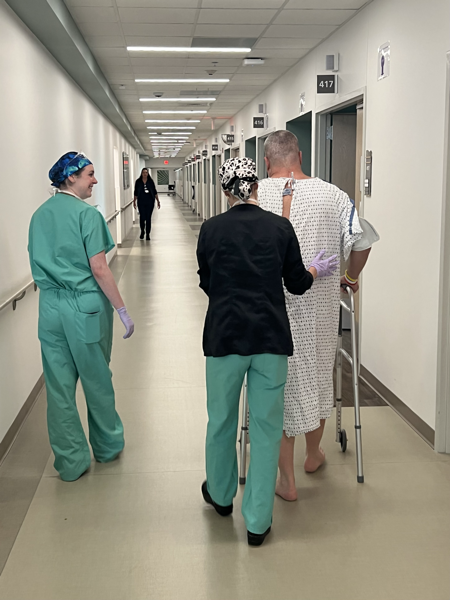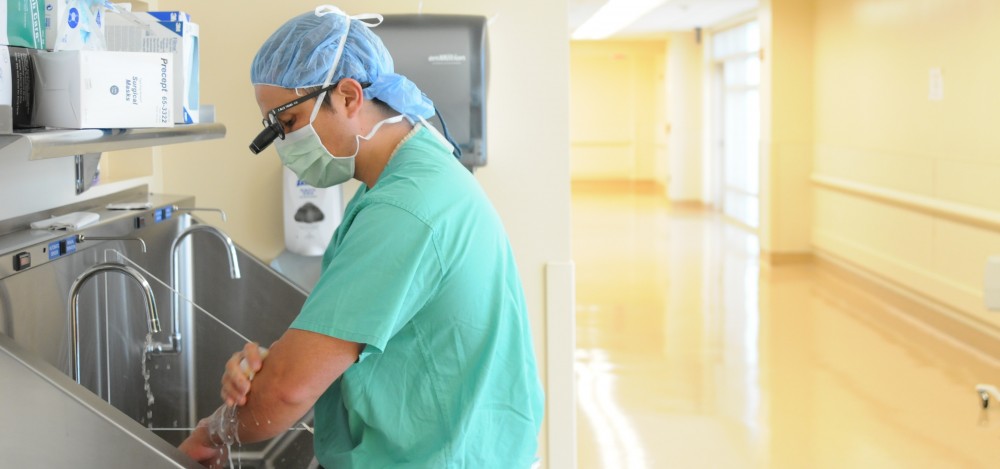When a patient undergoes a spinal surgery like a spinal fusion, there are several factors that can affect their odds of having a successful outcome. Sometimes these factors aren’t entirely under our control. If a patient comes in acutely injured from a trauma, for example, they may already have the deck stacked against them. In most instances, though, we can control the factors necessary to maximize the chances of an excellent surgical outcome. These factors are called modifiable factors. Some of these, like choosing the right surgical approach or perhaps the correct type of implants, are determined before surgery. Other factors like avoiding patient repositioning or the use of proper sterile technique occur intraoperatively. In my opinion, the best postoperative modifiable factor to ensure an excellent outcome after surgery is early ambulation.
In our practice we have a very particular routine on our surgery days; it’s a routine that I’m especially proud of. When the cases are done (no matter how tired we are) we’ll go up to the patient floor and we’ll force each of the day’s fusion patients to walk with us just hours after their surgery (including multi-level fusions!) Often the patient is doubtful that they’ll be up for the task given their immediate level of discomfort after the procedure (sometimes they look at us like we’re crazy!) Once we get them on their feet, though, and once they stretch out a bit, they notice immediate improvement in their pain level (paradoxically, a standard hospital bed is awful for recovery from spine surgery.) You can see it on their faces. Some patients can just take a few steps, others are ready to race us down the hallway (see figure 1.) Even the shortest amount of immediate ambulation is paramount, though.

Figure 1: Our outstanding PAs Catherine Zimel (left) and Karli Smiraglia help a fusion patient get his first few steps in only hours after surgery!
I’ve been doing this immediate post-op walking routine for all fusion patients for years now because I am certain that patients who ambulate earlier have not only better pain control but also less postoperative complications. The patients who walk on the day of surgery just do better. This isn’t just anecdotal; it’s been clearly demonstrated in the literature. In a study published this year out of the Hospital for Special Surgery in New York, Lovecchio et al examined 191 patients who underwent surgery for adult spinal deformity (large surgeries with multiple levels of the spine reconstructed and fused.) When they controlled for all other variables, they found that only delayed ambulation and larger Cobb angle (a more deformed spine) led to higher rates of complications—delayed ambulation led to an over 2X increase in complications! In another analysis of over 23,000 patients in a database of all patients undergoing lumbar spine surgery in Michigan, Zakaria and colleagues found a decreased length-of-stay and decreased risks of readmission, urinary tract infection, urinary retention (inability to urinate) and ileus in patients who ambulated on the day of surgery. The authors also estimated that ambulation on the day of surgery could result in nearly $75,000,000 in annual US healthcare savings just from the prevention of readmissions alone! Lastly, Adogwa and colleagues examined 125 elderly patients who underwent fusion surgery for spinal deformity. They found that the risk of at least one surgical complication was nearly 50% higher in a “late ambulator” group and that delaying ambulation for even 24hrs results in a significant increase in complications. We see this in our own patients too: the difference between a patient who ambulates on the day of surgery versus the patient who does not (because they’re too sedated or because they got to their room too late in the day) is immediately apparent the next morning when we come in for rounds. So, if you’re having a spinal fusion, if you advocate for nothing else for yourself immediately after surgery, make sure you’re getting someone to help you get up and walk (no matter how much it hurts!) Your recovery will be much better for it.
Thanks for reading!
J. Alex Thomas, M.D.
Adogwa O, Elsamadicy AA, Fialkoff J, Cheng J, Karikari IO, Bagley C. Early Ambulation Decreases Length of Hospital Stay, Perioperative Complications and Improves Functional Outcomes in Elderly Patients Undergoing Surgery for Correction of Adult Degenerative Scoliosis. Spine (Phila Pa 1976). 2017 Sep 15;42(18):1420-1425.
Lovecchio F, Jordan Y, Punyala A, Shah S, Lafage R, Charles Elysee J, Sheikh B, Steinhaus M, Ang B, Schwab F, Lafage V, Kim HJ. Timing of inpatient medical complications after adult spinal deformity surgery: early ambulation matters. Spine J. 2023 Feb;23(2):219-226.
Zakaria HM, Bazydlo M, Schultz L, Abdulhak M, Nerenz DR, Chang V, Schwalb JM. Ambulation on Postoperative Day #0 Is Associated With Decreased Morbidity and Adverse Events After Elective Lumbar Spine Surgery: Analysis From the Michigan Spine Surgery Improvement Collaborative (MSSIC). Neurosurgery. 2020 Aug 1;87(2):320-328.
